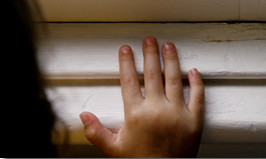Childhood Lead Exposure: MN Public Health Data Access – MN Dept. of Health
Childhood lead exposure
Lead exposure is dangerous for young children
It is important to protect children and young people from lead exposure. Elevated blood lead levels (EBLLs) in young children are linked with adverse health effects, including learning problems, behavioral problems, and even death if exposures are very high. Children less than 6 years of age living in homes built before 1978 are most at risk for lead exposure. Younger children are at greater risk because their bodies absorb lead more easily and their brains are still developing. If you live in an older home or are concerned your child might be exposed to lead, talk to your doctor about testing your child’s blood for lead.
Many houses built before 1978 have lead-based paint
Lead-based paint is a common source of lead exposure. Dust from lead paint can get in people’s homes from friction surfaces like windows and doors or from surfaces with chipping and peeling paint. People can be exposed to lead by accidently eating lead dust, paint chips, or other materials contaminated with lead, or breathing lead dust from renovation or work. Young children frequently put their hands or objects which may be contaminated with lead dust into their mouths.
Take steps to prevent lead exposure

Lead-based paint is the most common source of lead exposure. Paint that is on friction surfaces like windows and doors or chipping, flaking, or peeling is the greatest risk for exposure to lead in homes built before 1978. Soil can be contaminated with lead from exterior paint on buildings or past use of leaded gasoline. Other sources of lead include: adult occupations or hobbies, renovation, exposure from outside the United States, traditional medications, religious powders or cosmetics, pottery and ceramics, spices or imported food products, antiques, toys, jewelry or amulets, car keys, or fishing sinkers. More information about different sources of lead is available at MDH Common Sources of Lead.
Lead in water is not very common in Minnesota. Some homes or water sources can have higher lead levels and should be treated. Lead may get into drinking water when it passes through plumbing and distribution systems in the home that have lead in their parts. To prevent lead exposure, let your water run for 30-60 seconds before using it and use only cold water for drinking and making food or baby formula. If you are concerned about lead in your water, get it tested. More information is available at MDH Lead in Drinking Water.
Here are some things you can do to help reduce or prevent childhood lead exposure:
- Keep children and children’s furniture and cripbs away from chipping or peeling paint.
- Wash children’s hands, pacifiers, and toys often to remove dust.
- Regularly wet-wipe floors, window sills, and places where children play. Use a disposable cloth or paper towel to wet-wash floors and surfaces. Cleaning Up Lead Dust in Your Home has more detailed instructions about proper cleaning methods.
- Clean with a special vacuum that has a High Efficiency Particulate Air (HEPA) label on it.
- Have children play on grass instead of bare dirt.
- Take off shoes when entering a home to avoid tracking in soil that may contain lead.
- If you work with lead in your job or hobby, such as painting, remodeling, auto repair, plumbing, construction, or metal and battery manufacturing or recycling, change clothes and shower before you go home. Wash your hands before eating, drinking, smoking, or touching your face or anyone else.
- If your home was built before 1978 and you are doing painting, renovations, or repairs, make sure to use lead-safe work practices or hire someone with the right training and certifications. More information can be found at MDH Lead Poisoning Prevention Homeowner Information.
For more information about preventing childhood lead exposure, including cleaning up lead in your home, see the MDH Lead & Healthy Homes Program's Lead Fact Sheets and Brochures.
What is being done about childhood lead exposure?
The MDH Lead & Healthy Homes Program is a leader for childhood lead exposure prevention efforts statewide and implements the Childhood Lead Poisoning Prevention Program (CLPPP) cooperative agreement from the CDC, which contributes toward the elimination of childhood lead exposure as a public health problem. The MDH Lead & Healthy Homes Program provides lead exposure prevention education, support to individuals exposed to lead, and assistance to contractors and property owners in addressing lead issues.
Efforts to reduce lead exposure may mean fewer cases of childhood EBLLs in Minnesota:
- U.S. Housing rehabilitation programs, like those funded by the U.S. Department of Housing and Urban Development (HUD), focus on making homes lead-safe.
- Lead has been eliminated from paint, gasoline, and many consumer products and children's toys.
- Lead-related manufacturing has introduced greater controls to reduce occupational and environmental lead exposures.
However, each year there are still nearly 700 Minnesota children who have elevated blood lead levels. Reducing this number to zero will require ongoing efforts to eliminate sources of lead in the environment, prevent exposure to lead, and to detect rising blood lead levels sooner.
See the 2022 Blood Lead Surveillance Report (PDF) for the most recent data and information.
Childhood blood lead testing was not universal in Minnesota until recently
There is no safe level of lead. Testing the blood lead levels of children is important because it can help us identify who has been exposed to lead, find out where the source(s) of lead is coming from to get rid of it before it causes more irreversible damages. Lead testing was not universal in Minnesota until recently. The Childhood Blood Lead Screening Guidelines for Minnesota were updated in 2022 to recommend universal screening for all children at 12 and 24 months of age.
Related topics: